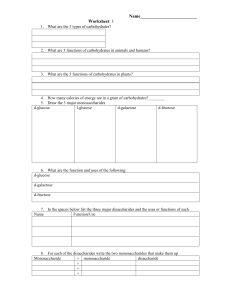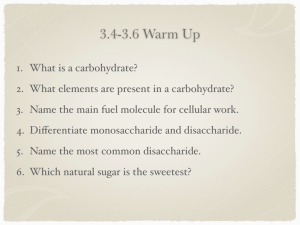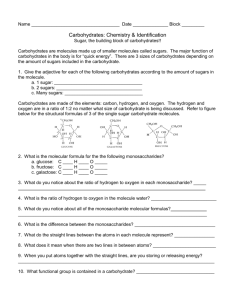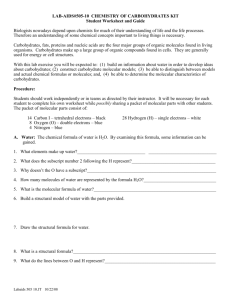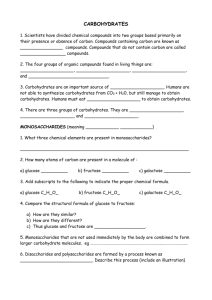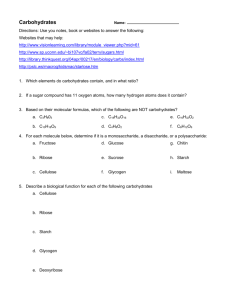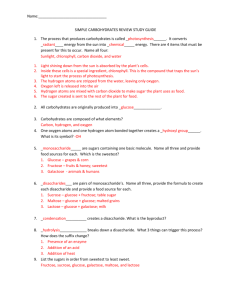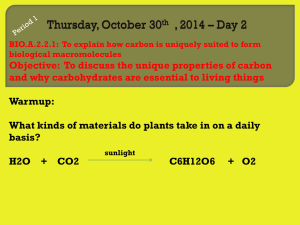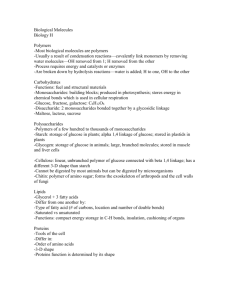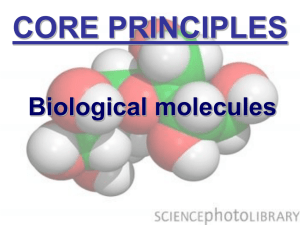Chemistry of Carbohydrates
advertisement
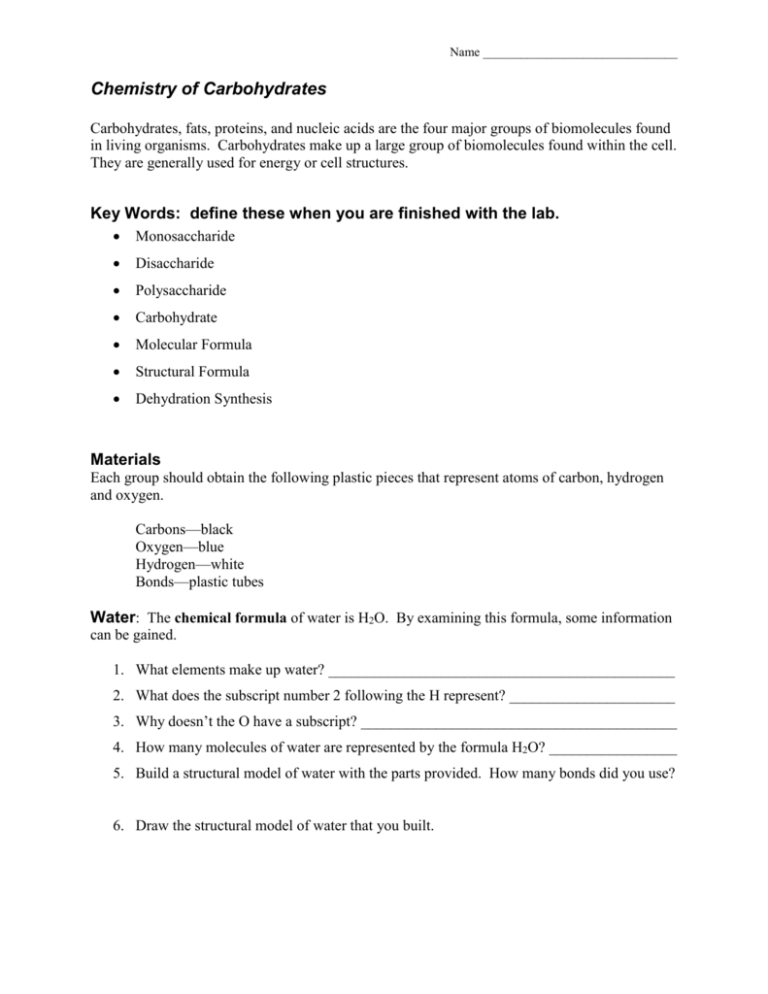
Name _______________________________ Chemistry of Carbohydrates Carbohydrates, fats, proteins, and nucleic acids are the four major groups of biomolecules found in living organisms. Carbohydrates make up a large group of biomolecules found within the cell. They are generally used for energy or cell structures. Key Words: define these when you are finished with the lab. Monosaccharide Disaccharide Polysaccharide Carbohydrate Molecular Formula Structural Formula Dehydration Synthesis Materials Each group should obtain the following plastic pieces that represent atoms of carbon, hydrogen and oxygen. Carbons—black Oxygen—blue Hydrogen—white Bonds—plastic tubes Water: The chemical formula of water is H2O. By examining this formula, some information can be gained. 1. What elements make up water? ______________________________________________ 2. What does the subscript number 2 following the H represent? ______________________ 3. Why doesn’t the O have a subscript? __________________________________________ 4. How many molecules of water are represented by the formula H2O? _________________ 5. Build a structural model of water with the parts provided. How many bonds did you use? 6. Draw the structural model of water that you built. II. Carbohydrates: an important group of biological compounds are the saccharides (the sugars of carbohydrates). Carbohydrates contain carbon, hydrogen, and oxygen. Carbohydrates are grouped into three main categories: Monosaccharides Disaccharides Polysaccharides Monosaccharides or simple sugars. Glucose Fructose Galactose 1. Study the structural formulas of glucose, fructose, and galactose above. They illustrate three different monosaccharides. 2. Construct two different models of the monosaccharides. 3. How many atoms of carbon are in each model? ________ Oxygen? _______ Hydrogen? ________ 4. Write the molecular formula for glucose: _______________________________ 5. Write the molecular formula for galactose: _______________________________ 6. Write the molecular formula for fructose: _______________________________ 7. Compare the number of hydrogen atoms to the number of oxygen atoms in each monosaccharide. What is the ratio of hydrogen to oxygen? _______: ________ 8. How does this ratio compare to the ratio in water? _______________________________ Disaccharides or double sugars. Two monosaccharide molecules can chemically join together to form a larger disaccharide. For example, when a glucose and a fructose join together, the disaccharide sucrose is formed. Sucrose is also known as table sugar. 1. In your group, construct a glucose and a fructose model. 2. Attempt to join the two molecules. Will they stay together? ____________ 3. It will be necessary to remove an –OH end (oxygen bonded to a hydrogen) from one molecule and an –H end from the other molecule in order to join them. Now can you connect the molecules? 4. The –OH and the –H ends that are removed combine to form a familiar molecule. What is it? _________________ 5. Count the number of carbons, hydrogens, and oxygens in your disaccharide. Write the molecular formula: _____________________________ 6. What is the ratio of hydrogen to oxygen in the disaccharide? _______: _________ Polysaccharides When many monosaccharides are joined together, a polysaccharide is produced. Examples of familiar polysaccharides are starch, glycogen, and cellulose. They are made up of 1000’s of glucose molecules connected together. Summary 1. Synthesis means the “process by which simple compounds are united to form more complex materials.” Dehydration means the “loss of water.” Explain why chemists refer to the joining of monosaccharides to form disaccharides as a dehydration synthesis reaction 2. The word carbohydrate is derived from carbon and water (hydrate). Explain why this combination correctly describes this chemical group. 3. Draw a structural formula of the disaccharide that you built: Going Further Examine the building blocks of a fat (a lipid) below: 1. The fat is made of _________ glycerol and __________ fatty acids. 2. The three fatty acids will connect to the glycerol to make a fat. How many waters are lost when these connections are made? _______ 3. Circle the areas on the molecules where these waters are lost. One has been done for you. 4. Now draw the completed fat below:
